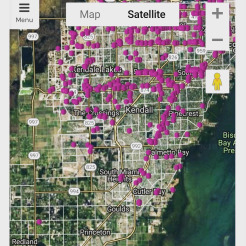-
I Need a Ride to the Dentist!!!

The maps listed shows the location of practicing dentists in the Miami,Fla area. Areas that are highlighted in orange/red are areas that experienced a high number of residents reporting not having a working vehicle at their home. Based on our research and maps created, you can see a huge shortage in availability of practicing dentists […]
-
Mapping Dentistry in Nashville, TN.

The map above shows the geographic location of dentists currently practicing in Davidson-County as well as areas that are likely experiencing disparities in oral health care. To bring awareness to the current health conditions in low-income areas such as North-Nashville, the Oral Health Needs Index (OHNI) made an easy-to-access, oral health focused, Geographic Information System […]
-
Mapping Emergency Room Dental Visits

This map shows the geographic location of all practicing dentists in the state of Florida by county and the dental ER visits per 1000 in primary care professional shortage areas. For better oral health outcomes to be possible in Florida, a data-driven, evidence-based program is essential. The Oral Health Needs Index(OHNI) made strides to fix […]
-
Dental Professionals Shortage Areas – Texas

A Health Professional Shortage Area (HPSA) is a geographic area, population, or facility with a shortage of primary care, dental, or mental health providers and services. The Health Resources and Services Administration (HRSA) and State Primary Care Offices (PCOs) work together using public, private, and state-provided data to determine when such a shortage qualifies for designation as an HPSA. […]
-
Geographic variation in use of Dental Treatment Services
Tooth decay is one of the most common childhood chronic diseases. It is a growing problem: according to CDC, among children ages, 2 to 5, the prevalence of early childhood caries increased 15 percent between 1988–1994 and 1999–2004. Untreated tooth decay affects 19.5 percent of 2-to-5-year-olds and 22.9 percent of 6-to-9-year-olds. The disease is almost entirely preventable through a […]
-
Drinking Water Fluoridation over the years
The first surveys on water fluoridation status in the United States were compiled in 1952 by the American Dental Association Council on Dental Health and the American Water Works Association. The surveys identified which communities were implementing this emerging technology. The U.S. Public Health Service has reported water fluoridation statistics periodically since 1956. The Water […]
-
Geographic variation in use of Preventive Dental Services
Tooth decay is one of the most common childhood chronic diseases. It is a growing problem: according to CDC, among children ages, 2 to 5, the prevalence of early childhood caries increased 15 percent between 1988–1994 and 1999–2004. Untreated tooth decay affects 19.5 percent of 2-to-5-year-olds and 22.9 percent of 6-to-9-year-olds. The disease is almost entirely preventable […]